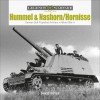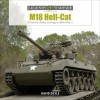Tuesday, October 01, 2019 - 08:41 PM UTC
Three new volumes from the Legends of Warfare series are expected for next year, covering the M18 Hellcat, Hummel/Nashorn and Panzer III
All of them are now available for preorder at a discounted price:
Hummel and Nashorn
The Hummel ("bumblebee") and Nashorn ("rhinoceros") are two of Nazi Germany's most widely recognized self-propelled artillery pieces. The Hummel, with its heavy field howitzer, was indispensable as heavy field artillery despite its open-top fighting compartment. The Nashorn, also known as the Hornisse ("hornet"), utilized the same chassis but mounted the formidable 88 mm antitank gun, becoming one of the most feared pieces of antitank artillery, or Panzerjäger ("tank hunter"). This book chronicles the development and use of these vehicles from concept to combat. Through dozens of archival photos, many never before published, as well as detailed photographs of some of the finest existent examples of surviving vehicles, these iconic armored fighting vehicles are explored, and their history is explained.
M18 Hellcat Tank Destroyer
The M18 was developed in an era when the United States fought tanks not with other tanks, but with specialized tank destroyers. With a powerful aircraft-style radial engine pushing it at up to 50 miles per hour, and mounting a potent 76 mm cannon, the Buick-built M18 Hellcat, or "Hell-Cat" as Buick's publicists named it, provided US troops with a powerful shoot-and-scoot answer to heavily armored German tanks. Further experiments were conducted to increase its armament or adapt it to other uses, such as the M39 armored utility vehicle. Through dozens of archival images, many never before published, as well as detailed photographs of some of the finest existent examples of these vehicles, this iconic tank hunter is explored, and its history is explained.
Panzer III
The Panzerkampfwagen III, or Panzer III as it is more commonly known, was a fixture in German armor formations during WWII. Initially developed to combat armored vehicles, in time the type evolved into an infantry support tank. Although production of the Panzer III ended in 1943, the type remained in service through the end of the war. Through over 160 photos, this volume chronicles the design, development, and deployment of this ubiquitous German tank. This material is arranged in nine chapters, each focusing on a specific production model, or Ausfrüng, of the tank. Comprehensive tables reveal the details of the performance and technical specifications of each variant. A concise, easy-to-read text and detailed captions expose the secrets of this iconic tank.
Hummel and Nashorn
The Hummel ("bumblebee") and Nashorn ("rhinoceros") are two of Nazi Germany's most widely recognized self-propelled artillery pieces. The Hummel, with its heavy field howitzer, was indispensable as heavy field artillery despite its open-top fighting compartment. The Nashorn, also known as the Hornisse ("hornet"), utilized the same chassis but mounted the formidable 88 mm antitank gun, becoming one of the most feared pieces of antitank artillery, or Panzerjäger ("tank hunter"). This book chronicles the development and use of these vehicles from concept to combat. Through dozens of archival photos, many never before published, as well as detailed photographs of some of the finest existent examples of surviving vehicles, these iconic armored fighting vehicles are explored, and their history is explained.
M18 Hellcat Tank Destroyer
The M18 was developed in an era when the United States fought tanks not with other tanks, but with specialized tank destroyers. With a powerful aircraft-style radial engine pushing it at up to 50 miles per hour, and mounting a potent 76 mm cannon, the Buick-built M18 Hellcat, or "Hell-Cat" as Buick's publicists named it, provided US troops with a powerful shoot-and-scoot answer to heavily armored German tanks. Further experiments were conducted to increase its armament or adapt it to other uses, such as the M39 armored utility vehicle. Through dozens of archival images, many never before published, as well as detailed photographs of some of the finest existent examples of these vehicles, this iconic tank hunter is explored, and its history is explained.
Panzer III
The Panzerkampfwagen III, or Panzer III as it is more commonly known, was a fixture in German armor formations during WWII. Initially developed to combat armored vehicles, in time the type evolved into an infantry support tank. Although production of the Panzer III ended in 1943, the type remained in service through the end of the war. Through over 160 photos, this volume chronicles the design, development, and deployment of this ubiquitous German tank. This material is arranged in nine chapters, each focusing on a specific production model, or Ausfrüng, of the tank. Comprehensive tables reveal the details of the performance and technical specifications of each variant. A concise, easy-to-read text and detailed captions expose the secrets of this iconic tank.
Click Star to Rate
4 readers have rated this story.
THIS STORY HAS BEEN READ 3,142 TIMES.











Comments